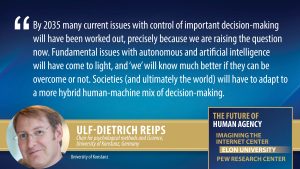Founded On Technology Innovation, AT&T Is Charting A Data And AI Future – Forbes

Report on AT&T’s Strategic Integration of Artificial Intelligence for Sustainable Development
Introduction: AI as a Core Driver for Business and Sustainability
AT&T, a company with a 150-year history of technological innovation, is strategically embedding Artificial Intelligence (AI) into its core operations to drive growth and advance its commitment to the United Nations Sustainable Development Goals (SDGs). Under the leadership of Chief Data and AI Officer Andy Markus, the company is leveraging its vast data resources to create value across its consumer and business lines while fostering a culture of responsible innovation. This report outlines AT&T’s AI strategy, its implementation across the firm, and its direct contributions to key SDGs, including SDG 8 (Decent Work and Economic Growth), SDG 9 (Industry, Innovation, and Infrastructure), SDG 12 (Responsible Consumption and Production), and SDG 13 (Climate Action).
Fostering Innovation and Resilient Infrastructure (SDG 9)
AT&T’s AI initiatives are fundamentally aligned with SDG 9, which calls for building resilient infrastructure, promoting inclusive and sustainable industrialization, and fostering innovation. The company’s long history, originating with Bell Labs, provides a foundation for its current leadership in AI development.
Strategic Implementation and Scale
- Historical Leadership: The company’s legacy includes foundational contributions to AI and a current ranking as sixth in the U.S. for AI patents.
- Modern AI Ecosystem: AT&T currently operates over 600 traditional Machine Learning (ML) and AI models in production.
- Generative AI Expansion: Over 2,000 generative AI use cases have been submitted for internal review, demonstrating a company-wide push to reimagine processes and create new efficiencies.
- Data Management: The firm manages approximately 900 petabytes of data flowing over its network daily, utilizing generative AI to enhance complex analytics and data product accuracy.
Enhancing Infrastructure Security and Reliability
To build a more resilient and trustworthy digital infrastructure, AT&T applies AI to critical security functions.
- Fraud Detection: A complex system using over 30 distinct generative and traditional AI models has been developed to protect customer data and assets from fraudulent activities.
- Robocall Mitigation: AI is employed to proactively detect and block robocalls, a major customer concern, thereby strengthening the integrity of the communications network.
Driving Sustainable Operations and Climate Action (SDG 12 & SDG 13)
AT&T is actively using AI to optimize its operations, leading to significant environmental benefits and promoting responsible production and consumption patterns in line with SDG 12 and SDG 13.
Fleet and Dispatch Optimization
A key example is the AI-driven optimization of one of the largest vehicle fleets in the United States. This program directly addresses climate action by enhancing efficiency.
- Fleet Size: The program manages over 50,000 vehicles.
- Emissions Reduction: By optimizing routes and proactively resolving issues to prevent unnecessary technician visits, the program has saved over 100 million pounds of carbon emissions.
- Resource Efficiency: This initiative reduces fuel consumption and vehicle miles driven, contributing to more sustainable corporate operations (SDG 12).
Promoting Decent Work and Economic Growth (SDG 8)
The company’s AI strategy includes a strong focus on empowering its workforce and delivering measurable economic value, directly supporting the objectives of SDG 8.
Workforce Development and Empowerment
- AI for All Employees: The Ask AT&T platform provides over 100,000 employees and contractors with access to generative AI tools, augmenting their daily activities and improving productivity.
- Cultural Transformation and Training: To ensure a successful transition, AT&T has implemented robust AI training programs. To date, 50,000 employees have completed AI training, fostering an AI-ready culture and upskilling the workforce for the jobs of the future.
- Executive Support: The AI transformation is supported at the highest levels, with CEO John Stankey championing the company-wide embrace of AI technology.
Delivering Economic Value
AI initiatives are governed by a transformation office that prioritizes use cases based on business value, ensuring that technological investment translates into sustainable economic growth.
- Return on Investment: For every dollar invested in generative AI, the company reported a 2X return on investment within the same year.
- Long-Term Financial Goals: These AI-driven efficiencies are on track to contribute to AT&T’s overall run-rate savings target of $3 billion by the end of 2027.
Conclusion: Preparing for a Sustainable AI Future
AT&T is positioning itself for a future where AI, including emerging agentic AI, is integral to every facet of its business. The company’s approach is not merely technological; it is a holistic strategy that integrates innovation with robust governance, workforce development, and a firm commitment to sustainability. By systematically applying AI to enhance efficiency, secure its infrastructure, and empower its employees, AT&T is demonstrating how a legacy technology firm can drive significant business value while making substantial contributions to the Sustainable Development Goals.
Analysis of Sustainable Development Goals in the Article
1. Which SDGs are addressed or connected to the issues highlighted in the article?
- SDG 8: Decent Work and Economic Growth: The article discusses how AT&T’s adoption of AI drives economic value, productivity, and financial returns. It also touches upon workforce development through extensive AI training programs for its employees.
- SDG 9: Industry, Innovation and Infrastructure: This is a central theme. The article details how AT&T, a company with a long history of innovation, is leveraging advanced AI to upgrade its technological capabilities, develop new intellectual property (patents), and enhance its infrastructure and business processes.
- SDG 11: Sustainable Cities and Communities: The article mentions AT&T’s dispatch optimization program for its large vehicle fleet. By reducing miles driven, this initiative contributes to more efficient and sustainable transport systems within communities.
- SDG 13: Climate Action: The article explicitly links AI innovation to climate action. The dispatch optimization program is cited as a direct measure to combat climate change by significantly reducing carbon emissions.
- SDG 16: Peace, Justice and Strong Institutions: The article highlights the use of AI to build systems that protect consumers and enhance security. The development of fraud detection systems and robocall blocking mechanisms contributes to reducing crime and creating safer, more accountable digital interactions.
2. What specific targets under those SDGs can be identified based on the article’s content?
- Target 8.2: Achieve higher levels of economic productivity through diversification, technological upgrading and innovation. The article explains how AT&T is using AI to automate processes, increase efficiency, and achieve significant financial returns (“returned 2X ROI”), which directly aligns with this target.
- Target 9.5: Enhance scientific research, upgrade the technological capabilities of industrial sectors in all countries, in particular developing countries, encouraging innovation and substantially increasing the number of research and development workers and public and private research and development spending. The article describes AT&T’s extensive R&D in AI, noting it “ranked sixth in U.S. companies with AI patents” and has developed “over 2,000 generative AI use cases.”
- Target 11.2: By 2030, provide access to safe, affordable, accessible and sustainable transport systems for all. The AI application that optimizes the dispatch process for over 50,000 vehicles contributes to this target by making the company’s transport operations more efficient and sustainable through “reducing the miles driven.”
- Target 13.2: Integrate climate change measures into national policies, strategies and planning. AT&T’s initiative to use AI for dispatch optimization is a corporate strategy that directly integrates climate change mitigation. The article states the benefit is “good for society because by being very efficient, we’re saving carbon emissions.”
- Target 16.4: By 2030, significantly reduce illicit financial and arms flows, strengthen the recovery and return of stolen assets and combat all forms of organized crime. The creation of a “complex fraud detection system” and the use of AI to block robocalls are direct actions to combat illicit activities and organized crime that affect customers.
3. Are there any indicators mentioned or implied in the article that can be used to measure progress towards the identified targets?
- Economic Return on Technology Investment: The article provides a direct metric for economic productivity gains from AI, stating, “for every dollar we invested, in that same year, we returned 2X ROI.” This can measure progress towards Target 8.2.
- Corporate Savings from Innovation: A financial indicator of efficiency is mentioned with the goal of a “run-rate that contributes to AT&T’s overall run-rate savings target of $3 billion by the end of 2027.” This also relates to Target 8.2.
- Volume of Innovation and R&D: Progress towards Target 9.5 is indicated by the volume of intellectual property and new applications, such as ranking “sixth in U.S. companies with AI patents” and creating “over 2,000 generative AI use cases.”
- Reduction in Carbon Emissions: The article provides a specific quantitative indicator for climate action (Target 13.2), noting “over 100 million pounds of emissions saved since we started this program.”
- Number of Employees Upskilled: As an indicator for workforce development (related to SDG 8), the article states that “50,000 employees have completed AI training.”
- Implementation of Security Systems: For Target 16.4, an implied indicator is the deployment and complexity of systems designed to fight crime. The article mentions a “complex fraud detection system with well over 30 models” and the successful use of AI in “detecting [robocalls] earlier and blocking them.”
4. Summary Table of SDGs, Targets, and Indicators
| SDGs | Targets | Indicators |
|---|---|---|
| SDG 8: Decent Work and Economic Growth | 8.2: Achieve higher levels of economic productivity through technological upgrading and innovation. |
|
| SDG 9: Industry, Innovation and Infrastructure | 9.5: Enhance scientific research and upgrade technological capabilities, encouraging innovation. |
|
| SDG 11: Sustainable Cities and Communities | 11.2: Provide access to sustainable transport systems for all. |
|
| SDG 13: Climate Action | 13.2: Integrate climate change measures into policies and planning. |
|
| SDG 16: Peace, Justice and Strong Institutions | 16.4: Significantly reduce illicit financial flows and combat all forms of organized crime. |
|
Source: forbes.com

What is Your Reaction?
 Like
0
Like
0
 Dislike
0
Dislike
0
 Love
0
Love
0
 Funny
0
Funny
0
 Angry
0
Angry
0
 Sad
0
Sad
0
 Wow
0
Wow
0












































































